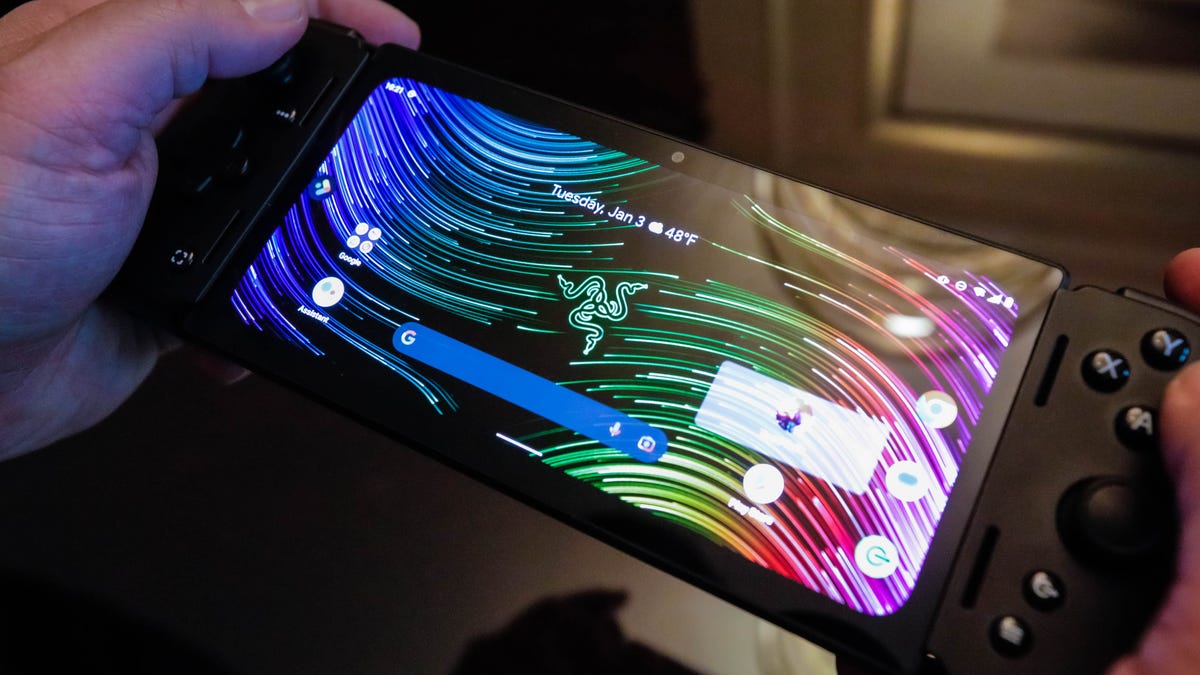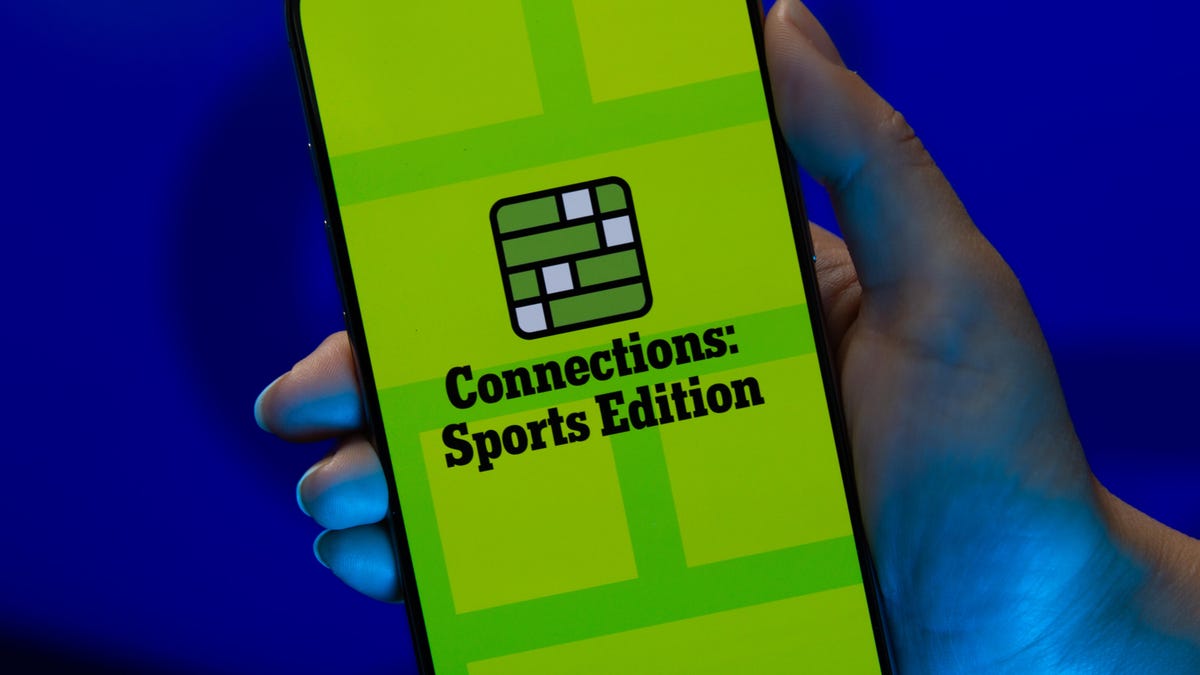Technologies
Razer Edge Game Handheld Is Here: Should You Buy One?
Razer’s Android gaming handheld is part mobile, part console. Here’s what to know.

Nearly a decade ago, Razer’s convertible gaming tablet, the Razer Edge, was my favorite product from CES. The Razer Edge has been reborn, this time as a 6.8-inch tablet handheld console for $400 that also comes in an optional, Verizon-exclusive 5G-equipped version. And it’s now available for purchase.
We don’t have a full review yet. We’re waiting on our Edge to arrive. But we can help you decide whether it’s worth buying right now.
The new Edge, long teased by Razer in various forms since Qualcomm and Razer first showed off a handheld concept a year ago using a new gaming-centric G3X Gen 1 mobile processor, isn’t a wild new idea like the first Edge was to me. It’s the latest in a trend of game handhelds adopting ideas in the spirit of the Nintendo Switch, bringing handheld gaming back in new forms. It’s also, in a sense, like the Logitech G Cloud released last year: an Android handheld game device focused on local and cloud game streaming.
The Edge isn’t a Steam Deck-alike, even if it costs the same as one: This is an Android tablet, more like a large 6.8-inch phone that’s not a phone. It has a similar feel to smaller tablets of the past, like the Nvidia Shield Tablet, but far slimmer.
Hands-on thoughts: Yes, it’s like a phone with a controller
At first, it’s… underwhelming. I’ve seen Razer’s Kishi snap-on game controllers for phones, and the Edge has the same concept. It uses an improved version of the Kishi design with support for vibrating haptics, which I didn’t get to experience. The tablet part, well, it’s a tablet, like many Android things.
The combination of parts could add up to more, though. The large, vivid, 6.8-inch AMOLED display does look lovely, and the new G3X chipset on this tablet could be better at handling streaming games. Razer boasts that it’ll be the ultimate way to try Xbox cloud gaming or playing games via Steam Link, although I also didn’t try that yet either.
But the specs are nice: It has a 2,400×1,080-pixel resolution display that runs at up to 144Hz, and the G3X processor promises active cooling to prolong game sessions. The 128GB of storage can be bumped to 2TB with a microSD card slot. The Kishi V2 Pro controller it comes with, which is removable, adds vibrating haptics the other models didn’t have before. It uses Google Play plus existing streaming game services and Razer’s already-working Nexus app for captures and gameplay streaming. Its advantage, to me, is that it’s not starting over — it’s leaning on what already works, aiming to do it better.
The few games I did play were locally stored games such as Dead Cells, an older 2D platformer. The Edge is wide and a bit long, but compared to a Nintendo Switch or a Steam Deck, it wouldn’t seem out of place.
Why not just buy a Kishi controller for your phone?
That’s the big question here. There are already several great snap-on controllers made for phones, and you could do the same and potentially get the same experience as the Edge. The Edge does have some added extras, including vibrating haptics in the controller and (maybe) boosted chip performance, but if you have a recent iPhone or Android phone, you might want to just convert what you have.
The Edge looks to propose a not-too-expensive solution, potentially, for those who don’t already have a phone… or who might want a dedicated device. That’s the idea, at least. How that ends up playing out versus a Steam Deck or a Nintendo Switch depends on whether you’d prefer to be in an Android ecosystem or not.
What about the 5G version?
We haven’t tested the Verizon-exclusive 5G model at all, but buying one with 5G obviously involves the cost of 5G service, and any other added costs via Verizon. Sure, that would mean the Edge would work anywhere with a decent Verizon cellular signal, but we don’t know how battery life on 5G will perform. If you really want an Edge, go with the regular Wi-Fi model and connect to a mobile hotspot.
Specs
The Razer Edge specs, in case you’re curious to compare against your phone, are:
- Qualcomm Snapdragon G3X Gen1 processor
- 2,400×1,080-pixel, 6.8-inch AMOLED display (144Hz)
- 8GB RAM
- 128GB internal storage (microSD card slot supports up to 2TB)
- Two microphones, two speakers
- Wi-Fi 6E
- Bluetooth 5.2
- USB-C port
- 3.5mm headphone jack
- eSIM for 5G model
- 260 x 85 x 11mm (10.2 x 3.3 x 0.4 inches)
- 264g (9.3 ounces) for tablet, 401g (14.1 ounces) for handheld and tablet together
You can wait it out
With something like the Edge, it all depends on how good it is at what it does. I can’t quite tell that yet. $400 is at least totally competitive with the cost of a Switch or Steam Deck. But would you want this over one of those? Or, would you just be happier using your phone and a similar controller? The Edge’s advantages seem intriguing, and I’m curious to play it more. But, with 2023 already looking to be a busy year for tech hardware releases, you also might want to wait to see what else is coming next.
Read more: The Must-See Tech of CES 2023: Sliding Foldables, Beastly OLED TVs and a Laptop-Charging Bike
Technologies
If You Were ‘Tricked’ Into an Amazon Prime Subscription, You Should Have Been Paid by Today
Amazon is paying $1.5 billion to people who mistakenly subscribed to Prime, and the first round of payments are due today.

Amazon Prime provides a lot of valuable benefits to its members, but the company’s registration practices for its premium subscription from 2019 to 2025 led to many customers accidentally subscribing to a service they didn’t want.
Amazon is now paying the price for that deception — the US Federal Trade Commission levied a massive $2.5 billion settlement on the company for its subscription tactics.
The majority of the settlement — $1.5 billion — has been earmarked to refund eligible subscribers, with the rest serving as a civil penalty. Amazon is also now legally required to provide a clear, obvious option to decline Prime, making it as easy to leave the service as it is to join.
Amazon isn’t admitting to shady behavior. «Amazon and our executives have always followed the law, and this settlement allows us to move forward and focus on innovating for customers,» Mark Blafkin, Amazon senior manager, said in a statement. «We work incredibly hard to make it clear and simple for customers to both sign up or cancel their Prime membership, and to offer substantial value for our many millions of loyal Prime members around the world.»
The online retail giant started sending out payments to eligible people in November and was supposed to conclude its initial automatic payments today, Dec. 24. Read on to learn more about Amazon’s settlement and what to do if you think you’re eligible for compensation but didn’t receive a payment.
Why did the FTC fine Amazon?
The FTC filed suit against Amazon, accusing the company of using «dark patterns» to nudge people into Prime subscriptions and then making it too hard to cancel. The FTC maintained Amazon was in violation of Section 5 of the FTC Act and the Restore Online Shoppers’ Confidence Act.
«Specifically, Amazon used manipulative, coercive or deceptive user-interface designs known as ‘dark patterns’ to trick consumers into enrolling in automatically renewing Prime subscriptions,» the FTC complaint stated.
Who’s eligible for Amazon’s payout?
Amazon’s legal settlement is limited to customers who enrolled in Amazon Prime between June 23, 2019, and June 23, 2025. It’s also restricted to customers who subscribed to Prime using a «challenged enrollment flow» or who enrolled in Prime through any method but were unsuccessful in canceling their memberships.
The FTC called out specific enrollment pages, including Prime Video enrollment, the Universal Prime Decision page, the Shipping Option Select page and the Single Page Checkout. To qualify for a payout, claimants must also not have used more than 10 Amazon Prime benefits in any 12-month period.
Customers who signed up via those challenged processes and did not use more than three Prime benefits within one year will be paid automatically by Amazon within 90 days. Other eligible Amazon customers will need to file a claim, and Amazon is required to send notices to those people within 30 days of making its automatic payments.
If you are eligible for the automatic payment, you should have received an email from Amazon by today explaining how to claim the money. You can be paid via PayPal or Venmo. If you prefer a paper check, don’t accept the digital payment. The FTC says Amazon will mail you a check that you must cash within 60 days.
How big will the Amazon payments be?
Payouts to eligible Amazon claimants will be limited to a maximum of $51. That amount could be reduced depending on the number of Amazon Prime benefits you used while subscribed to the service. Those benefits include free two-day shipping, watching shows or movies on Prime Video or Whole Foods grocery discounts.
Customers who qualify for the payments should have received them from Nov. 12 to Dec. 24, 2025.If you are eligible for compensation from Amazon but didn’t receive a payout, you’ll need to file a claim after Amazon starts the claim process. The FTC says it will update its Amazon settlement site once that process has begun.
Customers who did not use a challenged sign-up process but instead were unable to cancel their Prime memberships will also need to file claims for payment.
Technologies
Today’s NYT Connections: Sports Edition Hints and Answers for Dec. 25, #458
Here are hints and the answers for the NYT Connections: Sports Edition puzzle for Dec. 25, No. 458.

Looking for the most recent regular Connections answers? Click here for today’s Connections hints, as well as our daily answers and hints for The New York Times Mini Crossword, Wordle and Strands puzzles.
Today’s Connections: Sports Edition has a real mix of categories, including one that’s all about a certain famous athlete. If you’re struggling with today’s puzzle but still want to solve it, read on for hints and the answers.
Connections: Sports Edition is published by The Athletic, the subscription-based sports journalism site owned by The Times. It doesn’t appear in the NYT Games app, but it does in The Athletic’s app. Or you can play it for free online.
Read more: NYT Connections: Sports Edition Puzzle Comes Out of Beta
Hints for today’s Connections: Sports Edition groups
Here are four hints for the groupings in today’s Connections: Sports Edition puzzle, ranked from the easiest yellow group to the tough (and sometimes bizarre) purple group.
Yellow group hint: Swing away!
Green group hint: What’s that on your bat?
Blue group hint: Catch the football.
Purple group hint: Lake Placid or Lillehammer.
Answers for today’s Connections: Sports Edition groups
Yellow group: Baseball bat materials.
Green group: Associated with George Brett.
Blue group: NFL rookie WRs.
Purple group: Olympic ____.
Read more: Wordle Cheat Sheet: Here Are the Most Popular Letters Used in English Words
What are today’s Connections: Sports Edition answers?
The yellow words in today’s Connections
The theme is baseball bat materials. The four answers are aluminum, ash, birch and maple.
The green words in today’s Connections
The theme is associated with George Brett. The four answers are 5, pine tar, Royals and third base.
The blue words in today’s Connections
The theme is NFL rookie WRs. The four answers are Burden, Egbuka, Golden and McMillan.
The purple words in today’s Connections
The theme is Olympic ____. The four answers are Games, rings, torch and village.
Don’t miss any of our unbiased tech content and lab-based reviews. Add CNET as a preferred Google source.
Technologies
Christmas Eve Gaming Crushed as Steam Goes Offline
Services related to the popular game hub seem to slowly be returning as of Wednesday afternoon.

Your Christmas Eve gaming session might not go as planned. Online gaming hub Steam went down on Wednesday. As of about 1:30 pm PT, the Steam store page was once again accessible, so services seemed to be coming back online.
The Steam outage appeared to begin mid-afternoon ET, according to Downdetector, which monitors site outages. (Disclosure: Downdetector is owned by the same parent company as CNET, Ziff Davis.)
A representative for Steam did not immediately respond to a request for comment.
As of Wednesday noon PT, Steam’s official X and Bluesky accounts hadn’t posted anything about the outage.
Gamers certainly noticed. «Steam down, Steam down!!!» wrote one Bluesky user.
Others commented on the bad timing just as gamers were enjoying time off or receiving gaming gifts. «‘You got a gift on Steam!’ oh cool ‘Steam is down’ oh cool,» wrote another Bluesky user.
-

 Technologies3 года ago
Technologies3 года agoTech Companies Need to Be Held Accountable for Security, Experts Say
-

 Technologies3 года ago
Technologies3 года agoBest Handheld Game Console in 2023
-

 Technologies3 года ago
Technologies3 года agoTighten Up Your VR Game With the Best Head Straps for Quest 2
-

 Technologies4 года ago
Technologies4 года agoBlack Friday 2021: The best deals on TVs, headphones, kitchenware, and more
-

 Technologies4 года ago
Technologies4 года agoVerum, Wickr and Threema: next generation secured messengers
-

 Technologies4 года ago
Technologies4 года agoGoogle to require vaccinations as Silicon Valley rethinks return-to-office policies
-

 Technologies4 года ago
Technologies4 года agoOlivia Harlan Dekker for Verum Messenger
-

 Technologies4 года ago
Technologies4 года agoiPhone 13 event: How to watch Apple’s big announcement tomorrow
